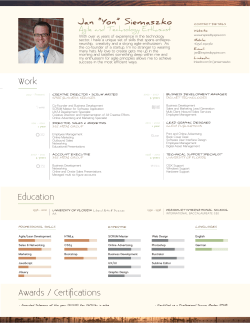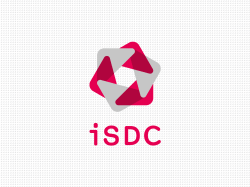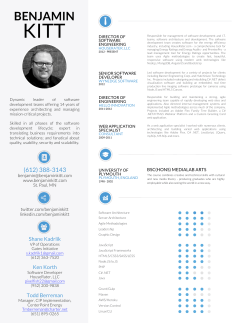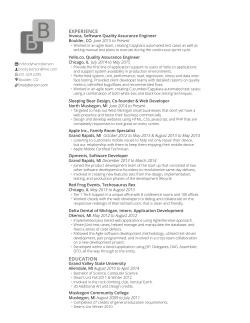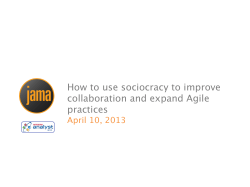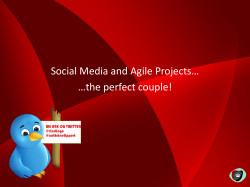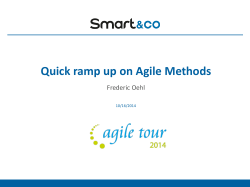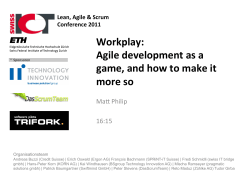
Lean & Agile Organizational Leadership
Lean & Agile Organizational Leadership “Some” Leadership History, Theory, Models, & Popular Ideas Dr. David F. Rico, PMP, CSEP, ACP, CSM, SAFe Twitter: @dr_david_f_rico Website: http://www.davidfrico.com LinkedIn: http://www.linkedin.com/in/davidfrico Facebook: http://www.facebook.com/david.f.rico.9 Agile Capabilities: http://davidfrico.com/rico-capability-agile.pdf Agile Resources: http://www.davidfrico.com/daves-agile-resources.htm Agile Cheat Sheet: http://davidfrico.com/key-agile-theories-ideas-and-principles.pdf Author BACKGROUND Gov’t contractor with 32+ years of IT experience B.S. Comp. Sci., M.S. Soft. Eng., & D.M. Info. Sys. Large gov’t projects in U.S., Far/Mid-East, & Europe Career systems & software engineering methodologist Lean-Agile, Six Sigma, CMMI, ISO 9001, DoD 5000 NASA, USAF, Navy, Army, DISA, & DARPA projects Published seven books & numerous journal articles Intn’l keynote speaker, 125+ talks to 12,000 people Specializes in metrics, models, & cost engineering Cloud Computing, SOA, Web Services, FOSS, etc. Adjunct at five Washington, DC-area universities 2 Information Age U.S. is no longer an industrial age nation U.S. part of a group of post industrial countries U.S. consists of information age knowledge workers 100% Percent of Economy 80% Information 60% Service Industry 40% Agriculture 20% 0% 1860 1870 1880 1890 1900 1910 1920 1930 1940 1950 1960 1970 1980 1990 Bell, D. (1999). The coming of post industrial society. New York, NY: Basic Books. 3 Today’s Whirlwind Environment Work Life Imbalance Vague Requirements Reduced IT Budgets Global Competition Overruns Attrition Escalation Runaways Cancellation Technology Change Demanding Customers Organization Downsizing System Complexity 81 Month Cycle Times Redundant Data Centers Obsolete Technology & Skills Inefficiency High O&M Lower DoQ Vulnerable N-M Breach Lack of Interoperability Overburdening Legacy Systems Poor IT Security Pine, B. J. (1993). Mass customization: The new frontier in business competition. Boston, MA: Harvard Business School Press. Pontius, R. W. (2012). Acquisition of IT: Improving efficiency and effectiveness in IT acquisition in the DoD. Second Annual AFEI/NDIA Conference on Agile in DoD, Springfield, VA, USA. 4 Global Project Failures Challenged and failed projects hover at 67% Big projects fail more often, which is 5% to 10% Of $1.7T spent on IT projects, over $858B were lost 2010 33% 41% 26% 2008 32% 44% 24% 35% Year 2006 2004 2002 2000 29% 1996 27% 0% 16% Successful 15% 49% 46% 33% 40% 23% 28% 40% 53% 20% 18% 51% 28% 26% 19% 53% 34% 1998 1994 46% $1.8 31% 60% Challenged 80% 100% Failed Trillions (US Dollars) $1.4 $1.1 $0.7 $0.4 $0.0 2002 2003 2004 2005 2006 2007 2008 2009 2010 Expenditures Standish Group. (2010). Chaos summary 2010. Boston, MA: Author. Sessions, R. (2009). The IT complexity crisis: Danger and opportunity. Houston, TX: Object Watch. Failed Investments 5 What is Agility? A-gil-i-ty (ә-'ji-lә-tē) Property consisting of quickness, lightness, and ease of movement; To be very nimble The ability to create and respond to change in order to profit in a turbulent global business environment The ability to quickly reprioritize use of resources when requirements, technology, and knowledge shift A very fast response to sudden market changes and emerging threats by intensive customer interaction Use of evolutionary, incremental, and iterative delivery to converge on an optimal customer solution Maximizing BUSINESS VALUE with right sized, justenough, and just-in-time processes and documentation Highsmith, J. A. (2002). Agile software development ecosystems. Boston, MA: Addison-Wesley. 6 What are Agile Methods? People-centric way to create innovative solutions Product-centric alternative to documents/process Market-centric model to maximize business value Customer Collaboration Frequent comm. Multiple comm. channels Close proximity Frequent feedback Regular meetings Relationship strength Individuals Leadership Boundaries Empowerment & Interactions Competence Courage Structure Manageability/Motivation Working Systems & Software Clear objectives Timeboxed iterations Small/feasible scope Valid operational results Regular cadence/intervals Acceptance criteria Responding to Change System flexibility Org. flexibility Technology flexibility Mgt. flexibility Process flexibility Infrastructure flexibility valued more than Contracts Contract compliance Contract deliverables Contract change orders valued more than Processes Lifecycle compliance Process Maturity Level Regulatory compliance valued more than Documentation Document deliveries Document comments Document compliance valued more than Project Plans Cost Compliance Scope Compliance Schedule Compliance Agile Manifesto. (2001). Manifesto for agile software development. Retrieved September 3, 2008, from http://www.agilemanifesto.org Rico, D. F., Sayani, H. H., & Sone, S. (2009). The business value of agile software methods. Ft. Lauderdale, FL: J. Ross Publishing. Rico, D. F. (2012). Agile conceptual model. Retrieved February 6, 2012, from http://davidfrico.com/agile-concept-model-1.pdf 7 How do Lean & Agile INTERSECT? Agile is naturally lean and based on small batches Agile directly supports six principles of lean thinking Agile may be converted to a continuous flow system Agile Values Lean Pillars Lean Principles Relationships Empowered Teams Customer Collaboration Respect for People Customer relationships, satisfaction, trust, and loyalty Team authority, empowerment, and resources Team identification, cohesion, and communication Product vision, mission, needs, and capabilities Customer Value Product scope, constraints, and business value Product objectives, specifications, and performance Value Stream As is policies, processes, procedures, and instructions To be business processes, flowcharts, and swim lanes Initial workflow analysis, metrication, and optimization Batch size, work in process, and artifact size constraints Continuous Flow Cadence, queue size, buffers, slack, and bottlenecks Workflow, test, integration, and deployment automation Iterative Delivery Responding to Change Lean & Agile Practices Continuous Improvement Customer Pull Perfection Roadmaps, releases, iterations, and product priorities Epics, themes, feature sets, features, and user stories Product demonstrations, feedback, and new backlogs Refactor, test driven design, and continuous integration Standups, retrospectives, and process improvements Organization, project, and process adaptability/flexibility Flow Principles Decentralization Economic View WIP Constraints & Kanban Control Cadence & Small Batches Fast Feedback Manage Queues/ Exploit Variability Womack, J. P., & Jones, D. T. (1996). Lean thinking: Banish waste and create wealth in your corporation. New York, NY: Free Press. Reinertsen, D. G. (2009). The principles of product development flow: Second generation lean product development. New York, NY: Celeritas. Reagan, R. B., & Rico, D. F. (2010). Lean and agile acquisition and systems engineering: A paradigm whose time has come. DoD AT&L Magazine, 39(6). 8 Agile World View “Agility” has many dimensions other than IT It ranges from leadership to technological agility The focus of this brief is program management agility Agile Leaders Agile Organization Change Agile Acquisition & Contracting Agile Strategic Planning Agile Capability Analysis Agile Program Management Agile Project Management Agile Systems Development Agile Processes & Practices Agile Tools Agile Information Systems Agile Tech. 9 Leadership History Many leadership theories emerged in last 100 years Many believe there is no unified theory of leadership Truth is some where in middle of old and new ideas Van Seters Northhouse Day Trait Personality Anti-Leader Culture Transform Integrative Motivation Charismatic Authentic Transactional Followership Relational Servant Contingency Courage Skeptical Transforming Situation Mind & Heart Contextual Exchange Operand Individual Contingency Path-Goal Late Behavior Contingency Behavior Contingency Early Behavior Trait Trait Skills Influence Daft Communication Transforming Team Informational Gender Culture Future Biological Evolutionary Emerging Team Diversity Vision & Culture Leading Change Van Seters, D. A., & Field, R. H. (1990). The evolution of leadership theory. Journal of Organizational Change Management, 3(3), 29–45. Daft, R. L. (2011). The leadership experience. Mason, OH: Thomson Higher Education. Day, D. V., & Anbtonakis, J. (2012). The nature of leadership. Thousand Oaks, CA: Sage Publications. Northouse, P. G. (2013). Leadership: Theory and practice. Thousand Oaks, CA: Sage Publications. 10 Models of AGILE DEVELOPMENT Agile methods spunoff flexible manufacturing 1990s Extreme Programming (XP) swept the globe by 2002 Today, over 90% of IT projects use Scrum/XP hybrid CRYSTAL METHODS - 1991 - SCRUM - 1993 - DSDM - 1993 - FDD XP - 1997 - - 1998 - Use Cases Planning Poker Feasibility Domain Model Release Plans Domain Model Product Backlog Business Study Feature List User Stories Object Oriented Sprint Backlog Func. Iteration Object Oriented Pair Programmer Iterative Dev. 2-4 Week Spring Design Iteration Iterative Dev. Iterative Dev. Risk Planning Daily Standup Implementation Code Inspection Test First Dev. Info. Radiators Sprint Demo Testing Testing Onsite Customer Reflection W/S Retrospective Quality Control Quality Control Continuous Del. Cockburn, A. (2002). Agile software development. Boston, MA: Addison-Wesley. Schwaber, K., & Beedle, M. (2001). Agile software development with scrum. Upper Saddle River, NJ: Prentice-Hall. Stapleton, J. (1997). DSDM: A framework for business centered development. Harlow, England: Addison-Wesley. Palmer, S. R., & Felsing, J. M. (2002). A practical guide to feature driven development. Upper Saddle River, NJ: Prentice-Hall. Beck, K. (2000). Extreme programming explained: Embrace change. Reading, MA: Addison-Wesley. 11 Models of AGILE PROJECT MGT. Dozens of Agile project management models emerged Many stem from principles of Extreme Programming Vision, releases, & iterative development common RADICAL - 2002 - EXTREME - 2004 - ADAPTIVE - 2010 - AGILE - 2010- SIMPLIFIED AGILE - 2011 - Prioritization Visionate Scoping Envision Vision Feasibility Speculate Planning Speculate Roadmap Planning Innovate Feasibility Explore Release Plan Tracking Re-Evaluate Cyclical Dev. Iterate Sprint Plan Reporting Disseminate Checkpoint Launch Daily Scrum Review Terminate Review Close Retrospective Thomsett, R. (2002). Radical project management. Upper Saddle River, NJ: Prentice-Hall. DeCarlo, D. (2004). Extreme project management: Using leadership, principles, and tools to deliver value in the face of volatility. San Francisco, CA: Jossey-Bass. Wysocki, R.F. (2010). Adaptive project framework: Managing complexity in the face of uncertainty. Boston, MA: Pearson Education. Highsmith, J. A. (2010). Agile project management: Creating innovative products. Boston, MA: Pearson Education. Layton, M. C., & Maurer, R. (2011). Agile project management for dummies. Hoboken, NJ: Wiley Publishing. 12 Models of AGILE PORTFOLIO MGT. Numerous models of agile portfolio mgt. emerging Based on lean-kanban, release planning, and Scrum Include organization, program, & project management ESCRUM - 2007 - SAFE LESS DAD RAGE - 2007 - - 2007 - - 2012 - Product Mgt Strategic Mgt Business Mgt Business Mgt Business Program Mgt Portfolio Mgt Portfolio Mgt Portfolio Mgt Governance Project Mgt Program Mgt Product Mgt Inception Portfolio Process Mgt Team Mgt Area Mgt Construction Program Business Mgt Quality Mgt Sprint Mgt Iterations Project Market Mgt Delivery Mgt Release Mgt Transition Delivery - 2013 - Schwaber, K. (2007). The enterprise and scrum. Redmond, WA: Microsoft Press. Leffingwell, D. (2007). Scaling software agility: Best practices for large enterprises. Boston, MA: Pearson Education. Larman, C., & Vodde, B. (2008). Scaling lean and agile development: Thinking and organizational tools for large-scale scrum. Boston, MA: Addison-Wesley. Ambler, S. W., & Lines, M. (2012). Disciplined agile delivery: A practitioner's guide to agile software delivery in the enterprise. Boston, MA: Pearson Education. Thompson, K. (2013). cPrime’s R.A.G.E. is unleashed: Agile leaders rejoice! Retrieved March 28, 2014, from http://www.cprime.com/tag/agile-governance 13 Models of AGILE LEADERSHIP Numerous theories of agile leadership have emerged Many have to do with delegation and empowerment Leaders have major roles in visioning and enabling AGILE - 2005 - EMPLOYEE - 2009 - RADICAL LEAN - 2010 - - 2010 - LEADERSHIP 3.0 - 2011 - Organic Teams Autonomy Self Org. Teams Talented Teams Empowerment Guiding Vision Alignment Communication Alignment Alignment Transparency Transparency Transparency Systems View Motivation Light Touch Purpose Iterative Value Reliability Scaling Simple Rules Mastery Delight Clients Excellence Competency Improvement Improvement Improvement Improvement Improvement Augustine, S. (2005). Managing agile projects. Upper Saddle River, NJ: Pearson Education. Pink, D. H. (2009). Drive: The surprising truth about what motivates us. New York, NY: Penguin Books. Denning, S. (2010). The leader’s guide to radical management: Reinventing the workplace for the 21st century. San Francisco, CA: John Wiley & Sons. Poppendieck, M, & Poppendieck, T. (2010). Leading lean software development: Results are not the point. Boston, MA: Pearson Education. Appelo, J. (2011). Management 3.0: Leading agile developers and developing agile leaders. Boston, MA: Pearson Education. 14 AGILE LEADERSHIP Model Created by Sanjiv Augustine at CC Pace in 2005 Builds agile cultures, mind-sets, & environment Leadership model for managing agile projects FOSTER ALIGNMENT AND COOPERATION ENCOURAGE EMERGENCE AND SELF ORGANIZATION LEARN & ADAPT Organic Teams Guiding Vision Simple Rules Open Information Light Touch Adapt. Leadership Leadership Leadership Leadership Leadership Leadership Leadership Craftsmanship Collaboration Team Vision Team Alignment Guiding Coalition Community Bold Future Shared Expectations Culture of Change Value Focus Conduct Standups Promote Feedback Adapt Style Roving Leadership Build Trust Facilitate Action Go With Flow Work Life Quality Embodied Presence Embodied Learning Build on Strengths Gain Commitments Management Management Identify Community Design Structures Business Outcomes Delineate Scope Get Team Players Adaptive Enterprise Management Management Management Management Assess Status Quo Customize Method Team Collocation Get Onsite Customer Decentralize Control Pull vs. Push Daily Feedback Monitor/Adapt Rules Estimate Effort Design Vision Box Release Plan Iteration Plans Practice Pairing Information Radiator Manage Flow Use Action Sprints Monitor Practices Retrospectives Elevator Statement Facilitate Design Conduct Testing Map Value Stream Scenario Planning Manage Releases Augustine, S. (2005). Managing agile projects. Upper Saddle River, NJ: Pearson Education. 15 EMPLOYEE LEADERSHIP Model Created by bestselling author Dan Pink in 2009 Integrates & reconciles field of motivation theories People more productive when enjoying themselves Employee Leadership Model Purpose Vision Goal Power Policy Culture Rejuvenation Autonomy Accountable Control Task Time Team Technique Mastery Inquiring Flow Mindset Learning Challenge Asymptotic Pink, D. H. (2009). Drive: The surprising truth about what motivates us. New York, NY: Riverhead Books. 16 RADICAL LEADERSHIP Model Created by bestselling author Steve Denning in 2010 Integrates leadership, client focus and agile methods Goal is delighting clients by exceeding expectations Radical Leadership Model Delighting Clients Self Org. Teams Client Driven Iterations Delivering Value Radical Transparency Continuous Improvement Interactively Communicate Identify clients Purpose Client focus Team focus Client interface Line-of-sight Storytelling Tacit desires Communicate Prioritize Preparation Daily contact Capture stories Simplicity Empowerment Client value Estimation Retrospectives Alignment Focus teams Offer less Tailor oversight Involvement Small batches Improvement Stimulation Exploration Recognition Simplicity Empowerment Radiators Make changes Succ. Stories People focus Remuneration Validate Communicate Impediments Get feedback Listen Meet clients Consistency Improve Sustainability Go-and-see Info. sharing Recognition Success Root causes Denning, S. (2010). The leader’s guide to radical management: Reinventing the workplace for the 21st century. San Francisco, CA: John Wiley & Sons. 17 LEAN LEADERSHIP Model Created by Mary & Tom Poppendieck in 2010 Integrates leadership, lean thinking & agile methods Goal is a customer-driven pull-system for leadership Lean Leadership Model SYSTEMS THINKING TECHNICAL EXCELLENCE RELIABLE DELIVERY RELENTLESS IMPROVEMENT GREAT PEOPLE ALIGNED LEADERS Customer Focus Essential Complexity Proven Experience Visualize Perfection Knowledge Workers Theory to Practice System Capability Quality by Construction Level Workflow Establish a Baseline Norm of Reciprocity Governance End-to-End Flow Evolutionary Development Expose Problems Mutual Respect Policy-Driven Waste Deep Expertise Learn to Improve Pride of Workmanship Pull Scheduling Adaptive Control Alignment Sustainability Poppendieck, M, & Poppendieck, T. (2010). Leading lean software development: Results are not the point. Boston, MA: Pearson Education. 18 LEADERSHIP 3.0 Model Created by Jurgen Appelo in 2011 (Netherlands) Integrative model for agile organizational leadership Focus on motivation, teamwork, purpose, & mastery Leadership 3.0 Model ENERGIZE PEOPLE EMPOWER TEAMS ALIGN CONSTRAINTS DEVELOP COMPETENCE GROW IMPROVE STRUCTURE EVERYTHING Manage Creativity Reduce Fear Shared Goal Optimize Whole Develop Leaders Improvement Motivate People Maturity Models Communication Coach & Mentor Select Teams Transition Team Intrinsic Rewards Authority Level Goal Autonomy Social Pressure Org. Style Change Env. Team Diversity Assign to Teams Leadership Angle Adaptable Tools Value Units Change Desire. Prof. Personality Practice Patience Protect People 360 Meetings Teams & Layers Ext. Feedback Team Values Massage Env. Constrain Quality Grow Standards Hybrid Org. Tailor Changes No Door Policy Trust & Respect Social Contract Work the System Transparency Retrospectives Appelo, J. (2011). Management 3.0: Leading agile developers and developing agile leaders. Boston, MA: Pearson Education. 19 Other LEADERSHIP CONSIDERATIONS Power & authority delegated to the lowest level Tap into the creative nuclear power of team’s talent Coaching, communication, and relationships key skills Personal Project Enterprise • Don't Be a Know-it-All • Be Open & Willing to Learn • Customer Communication • Business Value vs. Scope • Product Visioning • Interactions vs. Contracts • Treat People Respectfully • Distribution Strategy • Relationship vs. Regulation • • • • • Team Development • Conversation vs. Negotiation • Consensus vs. Dictatorship Be Gracious, Humble, & Kind Listen & Be Slow-to-Speak Be Patient & Longsuffering Be Objective & Dispassionate • Standards & Practices • Telecom Infrastructure • Development Tools • Collaboration vs. Control • Openness vs. Adversarialism • Exploration vs. Planning • Don't Micromanage & Direct • High-Context Meetings • Exhibit Maturity & Composure • Don't Escalate or Exacerbate • Don't Gossip or be Negative • Coordination & Governance • F2F Communications • Delegate, Empower, & Trust • Performance Management • Entrepreneurial vs. Managerial • Creativity vs. Constraints • Satisfaction vs. Compliance • Personal Development • Quality vs. Quantity • Gently Coach, Guide, & Lead • Consensus Based Decisions • Incremental vs. All Inclusive Rico, D. F. (2013). Agile coaching in high-conflict environments. Retrieved April 11, 2013 from http://davidfrico.com/agile-conflict-mgt.pdf Rico, D. F. (2013). Agile project management for virtual distributed teams. Retrieved July 29, 2013 from http://www.davidfrico.com/rico13m.pdf Rico, D. F. (2013). Agile vs. traditional contract manifesto. Retrieved March 28, 2013 from http://www.davidfrico.com/agile-vs-trad-contract-manifesto.pdf 20 Org. CHANGE LEADERSHIP MODELS Change, no matter how small or large, is difficult Smaller focused changes help to cross the chasm Simplifying, motivating, and validation key factors SWITCH MAKE IT DESIRABLE DIRECT THE RIDER Follow the bright spots Script the critical moves Create new experiences Create new motives SURPASS YOUR LIMITS Point to the destination Perfect complex skills Build emotional skills Recruit public figures Recruit influential leaders Find the feeling Shrink the change STRENGTH IN NUMBERS Grow your people Utilize teamwork Power of social capital SHAPE PATH DESIGN REWARDS Tweak the environment Use incentives wisely Use punishment sparingly Rally the herd USE PEER PRESSURE MOTIVATE ELEPHANT Build habits DRIVE INFLUENCER CHANGE ENVIRONMENT Make it easy Make it unavoidable PURPOSE Purpose-profit equality Business& societal benefit Share control of profits Delegate implementation Culture & goal alignment Remake society-globe AUTONOMY Accountable to someone Self-select work tasks Self-directed work tasks Self-selected timelines Self-selected teams Self-selected implement. TO SELL IS HUMAN DECISIVE ATTUNEMENT Reduce Your Power Take Their Perspective Use Strategic Mimicry COMMON ERRORS Narrow framing Confirmation bias Short term emotion Over confidence WIDEN OPTIONS BUOYANCY Avoid a narrow frame Multi-track Find out who solved it Use Interrogative Self-Talk Opt. Positivity Ratios Offer Explanatory Style MASTERY CLARITY Experiment & innovate Align tasks to abilities Continuously improve Learning over profits Create challenging tasks Set high expectations Find the Right Problem Find Your Frames Find an Easy Path TEST ASSUMPTIONS Consider the opposite Zoom out & zoom in Ooch ATTAIN DISTANCE Overcome emotion Gather & shift perspective Self-directed work tasks PREPARE TO BE WRONG Bookend the future Set a tripwire Trust the process Heath, C., & Heath, D. (2010). Switch: How to change things when change is hard. New York, NY: Random House. Patterson, K., et al. (2008). Influencer: The power to change anything: New York, NY: McGraw-Hill. Pink, D. H. (2009). Drive: The surprising truth about what motivates us. New York, NY: Riverhead Books. Pink, D. H. (2012). To sell is human: The surprising truth about moving others. New York, NY: Riverhead Books. Heath, C., & Heath, D. (2013). Decisive: How to make better choices in life and work. New York, NY: Random House. 21 21ST CENTURY LEADERSHIP Summary 21st century leadership is about empowerment vs. ctrl Flatter organizations of talented self-organizing teams Lean-agile ideas to constantly adapt to market needs FLATTER - Develop flatter enterprises, organizations, agencies, non-profits, firms, etc. BOTTOMS UP - Deploy bottoms up visioning, missioning, strategic/tactical planning, etc. VISIONING - Continuously proliferate jointly developed visions, missions, strategies, etc. DELEGATE - Delegate authority and responsibility to lowest operational level possible. LEAN THINKING - Promote small batch sizes, low work in process (WIP), Kanban, etc. ADAPTABILITY - Continuously sense and respond to ever changing market needs. MICRO THINKING - Use small throwaway micro batches, products, services, timelines, etc. FLEXIBILITY - Use flexible and inexpensive processes, products, suppliers, services, etc. EMERGENCE - Allow business, product, and service offerings to evolve, emerge, grow, etc. SELF ORGANIZATION - Develop loose coalitions of inter-networked teams vs. hierarchies. CONVERSATIONS - Foster open, informal communications, dialogues, conversations, etc. BALANCE - Strike a balance between organizational commitments and creative pursuits. AGILITY - Find balance of flexibility and discipline for creative, high-quality solutions. IMPROVEMENT - Create a culture of continuous improvement, learning, perfection, etc. MASTERY - Foster an environment of learning, education, self-mastery, perfection, etc. COLLABORATION - Integrate market, customer, and voice, feedback, participation, etc. 22 Dave’s Professional Capabilities Organization Change Government Acquisitions Government Contracting Cost Estimating Systems Engineering BPR, IDEF0, & DoDAF Valuation — Cost-Benefit Analysis, B/CR, ROI, NPV, BEP, Real Options, etc. CMMI & ISO 9001 Technical Project Mgt. PSP, TSP, & Code Reviews Software Development Methods Innovation Management Evolutionary Design Software Quality Mgt. Research Methods Lean-Agile — Scrum, SAFe, Continuous Integration & Delivery, DevOps, etc. DoD 5000, TRA, & SRA Statistics, CFA, EFA, & SEM Lean Kanban Six Sigma Metrics, Models, & SPC Workflow Automation Big Data, Cloud, NoSQL STRENGTHS – Data Mining Gathering & Reporting Performance Data Strategic Planning Executive & Management Briefs Brownbags & Webinars White Papers Tiger-Teams Short-Fuse Tasking Audits & Reviews Etc. 32 YEARS IN IT INDUSTRY ● ● ● ● ● Action-oriented. Do first (talk about it later). Data-mining/analysis. Collect facts (then report findings). Simplification. Communicating complex ideas (in simple terms). Git-r-done. Prefer short, high-priority tasks (vs. long bureaucratic projects). Team player. Consensus-oriented collaboration (vs. top-down autocratic control). PMP, CSEP, ACP, CSM, & SAFE 23 Books on ROI of SW Methods Guides to software methods for business leaders Communicates the business value of IT approaches Rosetta stones to unlocking ROI of software methods http://davidfrico.com/agile-book.htm (Description) http://davidfrico.com/roi-book.htm (Description) 24
© Copyright 2025
